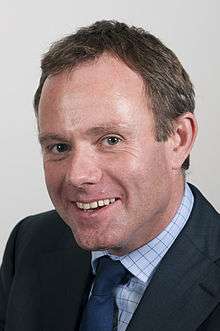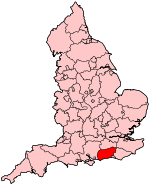Arundel and South Downs (UK Parliament constituency)
Coordinates: 51°51′22″N 0°33′32″W / 51.856°N 0.559°W
| Arundel and South Downs | |
|---|---|
|
County constituency for the House of Commons | |
|
Boundary of Arundel and South Downs in West Sussex. | |
|
Location of West Sussex within England. | |
| County | West Sussex |
| Population | 97,267 (2011 census)[1] |
| Electorate | 76,697 (December 2010)[2] |
| Major settlements | Arundel, Hassocks, Petworth, Pulborough and Steyning |
| Current constituency | |
| Created | 1997 |
| Member of parliament | Nick Herbert (Conservative) |
| Number of members | One |
| Created from | Arundel and Horsham |
| Overlaps | |
| European Parliament constituency | South East England |
Arundel and South Downs /ˈærᵿndəl ənd saʊθ daʊnz/ is a constituency[n 1] represented in the House of Commons of the UK Parliament since 2005 by Nick Herbert of the Conservative Party.[n 2]
Boundaries
The constituency contains the town of Arundel, and many villages and hamlets along the South Downs, including Petworth, Pulborough and Steyning.
Boundary review
Following their review of parliamentary boundaries in West Sussex that was approved in 2007, the Boundary Commission for England made alterations to all existing constituencies to deal with population changes. The Arundel and South Downs constituency was created with the following electoral wards:
- From the District of Arun – Angmering, Arundel, Barnham, Findon, and Walberton
- From Chichester – Bury, Petworth, and Wisborough Green
- From Horsham – Bramber, Upper Beeding and Woodmancote, Chanctonbury, Chantry, Cowfold,Partridge Green, Shermanbury and West Grinstead, Henfield, Pulborough and Coldwaltham, and Steyning
- From Mid Sussex – Hassocks, and Hurstpierpoint and Downs.
History
Arundel and South Downs and its predecessor seats have in the 20th century been a Conservative Party stronghold.
The incumbent had national media coverage in the run-up to the 2005 general election due to the deselection requested by the party leader of its sitting Conservative member, Howard Flight a member of Conservative Way Forward who proposed that if elected, spending cuts could be more severe than set out in the small cuts in the 2005 manifesto, in other words in his opinion to this audience he thought the party would likely stray in actual policy from what had been publicised. He had represented the constituency since its creation at the 1997 general election. Anne Marie Morris, Laura Sandys and Nick Herbert put themselves forward for nomination as replacement candidates. The chosen candidate, Nick Herbert, won the seat at the election.[3] Morris and Sandys became MPs elsewhere in 2010.
In their recommendations, the Boundary Commission for England initially suggested calling the new constituency Chanctonbury after Chanctonbury Ring, an ancient hill fort at its centre. This name was rejected during the local inquiry process at which the current name was chosen.[4]
Prior to 1997, this seat had been split between other constituencies. Between 1983 and 1997, the town of Arundel had been part of the eponymous Arundel constituency, which also included the towns of Bognor Regis and Littlehampton, and the area of the South Downs had been part of the Horsham constituency.
Between 1974 and 1983, much of the South Downs area was part of the Shoreham constituency, with the town of Arundel remaining in the Arundel constituency.
Prior to 1974, the seat was largely part of the Arundel and Shoreham constituency.
Members of Parliament
| Election | Member[5] | Party | ||
|---|---|---|---|---|
| 1997 | Howard Flight | Conservative | ||
| 2005 | Nick Herbert | Conservative |  | |
Elections
Elections in the 2010s
| Party | Candidate | Votes | % | ± | |
|---|---|---|---|---|---|
| Conservative | Nick Herbert | 34,331 | 60.8 | +3.0 | |
| UKIP | Peter Grace | 8,154 | 14.4 | +8.8 | |
| Labour | Christopher Wellbelove | 6,324 | 11.2 | +2.6 | |
| Liberal Democrat | Shweta Kapadia | 4,062 | 7.2 | −20.7 | |
| Green | Isabel Thurston | 3,606 | 6.4 | +6.4 | |
| Majority | 26,177 | 46.3 | +16.4 | ||
| Turnout | 56,477 | 73.1 | +0.9 | ||
| Conservative hold | Swing | −2.9 | |||
| Party | Candidate | Votes | % | ± | |
|---|---|---|---|---|---|
| Conservative | Nick Herbert | 32,333 | 57.8 | +8.0 | |
| Liberal Democrat | Derek Deedman | 15,642 | 27.9 | +0.8 | |
| Labour | Tim Lunnon | 4,835 | 8.6 | −8.5 | |
| UKIP | Stuart Bower | 3,172 | 5.7 | +0.3 | |
| Majority | 16,691 | 29.9 | |||
| Turnout | 55,982 | 72.2 | +1.4 | ||
| Conservative hold | Swing | +3.6 | |||
Elections in the 2000s
| Party | Candidate | Votes | % | ± | |
|---|---|---|---|---|---|
| Conservative | Nick Herbert | 24,752 | 49.8 | −2.4 | |
| Liberal Democrat | Derek Deedman | 13,443 | 27.1 | +4.7 | |
| Labour | Sharon Whitlam | 8,482 | 17.1 | −3.6 | |
| UKIP | Andrew Moffat | 2,700 | 5.4 | +0.7 | |
| Protest Vote Party | Mark Stack | 313 | 0.6 | +0.6 | |
| Majority | 11,309 | 22.8 | |||
| Turnout | 49,690 | 68.5 | 3.8 | ||
| Conservative hold | Swing | −3.5 | |||
| Party | Candidate | Votes | % | ± | |
|---|---|---|---|---|---|
| Conservative | Howard Flight | 23,969 | 52.2 | −0.9 | |
| Liberal Democrat | Derek R. Deedman | 10,265 | 22.4 | −3.4 | |
| Labour | Charles S. Taylor | 9,488 | 20.7 | +2.4 | |
| UKIP | Robert Perrin | 2,167 | 4.7 | +1.8 | |
| Majority | 13,704 | 29.8 | |||
| Turnout | 45,889 | 64.7 | −10.8 | ||
| Conservative hold | Swing | +1.25 | |||
Elections in the 1990s
| Party | Candidate | Votes | % | ± | |
|---|---|---|---|---|---|
| Conservative | Howard Flight | 27,251 | 53.1 | N/A | |
| Liberal Democrat | John Michael Goss | 13,216 | 25.7 | N/A | |
| Labour | Richard Black | 9,376 | 18.3 | N/A | |
| UKIP | James Thomas Herbert | 1,494 | 2.9 | N/A | |
| Majority | 14,035 | 27.3 | N/A | ||
| Turnout | 51,337 | 75.5 | N/A | ||
| Conservative win (new seat) | |||||
See also
Notes and references
- Notes
- ↑ A county constituency (for the purposes of election expenses and type of returning officer)
- ↑ As with all constituencies, the constituency elects one Member of Parliament (MP) by the first past the post system of election at least every five years.
- References
- ↑ "Usual Resident Population, 2011". Neighbourhood Statistics. Office for National Statistics. Retrieved 26 January 2015.
- ↑ "Electorate Figures – Boundary Commission for England". 2011 Electorate Figures. Boundary Commission for England. 4 March 2011. Archived from the original on 6 November 2010. Retrieved 13 March 2011.
- ↑ http://newsrss.bbc.co.uk/1/hi/uk_politics/4407361.stm
- ↑ Boundary Commission for England, fourth periodic report, 1995
- ↑ Leigh Rayment's Historical List of MPs – Constituencies beginning with "A" (part 3)
- ↑ "Election Data 2015". Electoral Calculus. Archived from the original on 17 October 2015. Retrieved 17 October 2015.
- ↑ "Election Data 2010". Electoral Calculus. Archived from the original on 26 July 2013. Retrieved 17 October 2015.
- ↑ "Election Data 2005". Electoral Calculus. Archived from the original on 15 October 2011. Retrieved 18 October 2015.
- ↑ "Election Data 2001". Electoral Calculus. Archived from the original on 15 October 2011. Retrieved 18 October 2015.
- ↑ "Election Data 1997". Electoral Calculus. Archived from the original on 15 October 2011. Retrieved 18 October 2015.
Sources
- Election result, 2005 (BBC)
- Election results, 1997 – 2001 (BBC)
- Election results, 1997 – 2001 (Election Demon)
- Election results, 1997 – 2005 (Guardian)

